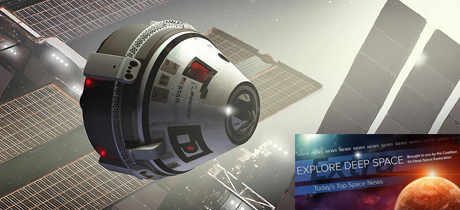In Today’s Deep Space Extra… Congressional auditors on Wednesday offered a harsh assessment of NASA’s efforts to develop the large rocket, crew capsule and ground systems needed to resume human deep space exploration. The National Academies urged NASA to pursue an infrared space telescope dedicated to the discovery, characterization and tracking of asteroids that could pose an impact threat to Earth. A large sample of international astronauts talk about what it means to fly in space.
Human Space Exploration
GAO blasts NASA for understating cost growth on SLS/Orion, NASA shooting back
Coalition Member in the News – Boeing, Lockheed Martin
Spacepolicyonline.com (6/19): The U.S. General Accountability Office (GAO), the audit arm of Congress, offered a harsh assessment of NASA’s efforts to develop the Space Launch System (SLS), Orion crew capsule and supporting ground launch systems to resume the human exploration of deep space, starting with a return to the surface of the Moon in 2024. NASA’s response focused on the challenge of developing some of the most sophisticated hardware ever assembled.
Will humans really be back on the moon by 2024? A Q&A with space experts
Politico (6/19): The publication has turned to a collection of people with knowledge of Artemis, NASA’s strategy to return to the surface of the Moon with human explorers by 2024. They speak to the likelihood of success, the reasoning and impact to life on Earth and other factors.
What the Space Age taught us: Earth is the best of all possible worlds
Washington Post (6/18): The 50th anniversary of Apollo 11, which marked the first human landing on the surface of the Moon, is coming on July 20. Among the many revelations coming from the historic event are the many challenges of human space travel. They point towards how crucial the Earth is to humanity.
Space Science
Space-based infrared telescope for planetary defense gets boost from National Academies
Spacepolicyonline.com (6/20): In a report requested by NASA, the National Academies of Sciences, Engineering and Medicine on Wednesday endorsed an asteroid surveillance mission called NEOcam, a space telescope with infrared optics designed to find asteroids, or Near Earth Objects, that could pose an impact threat to Earth and help characterize their orbital path and mass. The mission’s first order would be to identify asteroid threats 140 meters in width and larger. The Academies urged NASA not to force planetary defense missions to compete with planetary science missions for NASA funding and not to end the detection role currently assigned to ground-based observatories.
Small satellite concept finalists target Moon, Mars and beyond
NASA (6/19): A pair of asteroids, Mars and the Moon are the potential destinations for three finalists in a NASA sponsored launch competition under the auspices of the agency’s Planetary Division small innovation mission banner.
Comets are teaching us how to make breathable oxygen in space
Astronomy (6/3): According to a study by Caltech, comets could be a space resource for O2, molecular oxygen, for life support and rocket propellant. And they make it naturally from carbon dioxide.
Other News
Commercial space companies have received $7.2 billion in government investment since 2000
Verge (6/18): The $7.2 billion investment is the total from NASA and U.S. Air Force in commercial companies, dating back 18 years, according to Space Angels, an investment firm. Some 67 companies have been the recipients of federal investments that can make the difference between success and failure. Most of the funding has gone to launch service companies in an effort to introduce new technologies and methods that reduce costs.
If it’s Boeing (space), it’s going to Florida
Coalition Member in the News – Boeing
Spaceflightinsider.com (6/19): Boeing is moving its space operations headquarters from Arlington, Virginia, in the Washington D.C. area, to Florida’s space coast, closer to operations of the company’s commercial crew CST-100 Starliner vehicle and Space Launch System (SLS), a cornerstone component of NASA’s efforts to resume human deep space exploration.
Airbus seeks new partners to expand in U.S. space market
Reuters via New York Times (6/18): Holland based Airbus is seeking partners to expand a presence in the U.S. space launch market, including a possible role in NASA’s lunar exploration program. Under Artemis, NASA is partnering with commercial companies and international partners to return human explorers to the surface of the Moon in 2024.
Apollo 11
50 astronauts, in their own words
Washington Post (6/19): As the nation marks the upcoming 50th anniversary of Apollo 11, the first time astronauts landed on the Moon on July 20, 1969, the Post spoke with 50 men and women from seven countries who’ve flown in space and what it was like.
PBS celebrates the lunar landing’s anniversary with a space miniseries
Endgaget (6/19): PBS plans a six episode series marking the July 50th anniversary of Apollo 11, the first human landing of human explorers on the surface of the Moon. The premier episode, Stellar, debuts on July 20.

